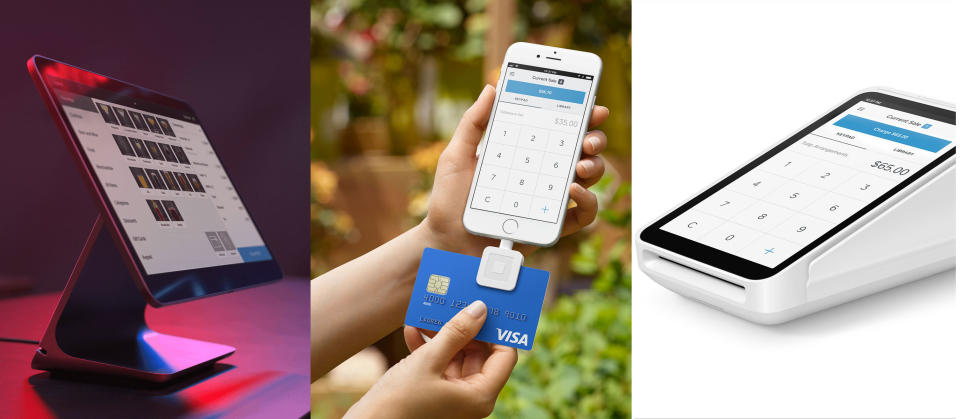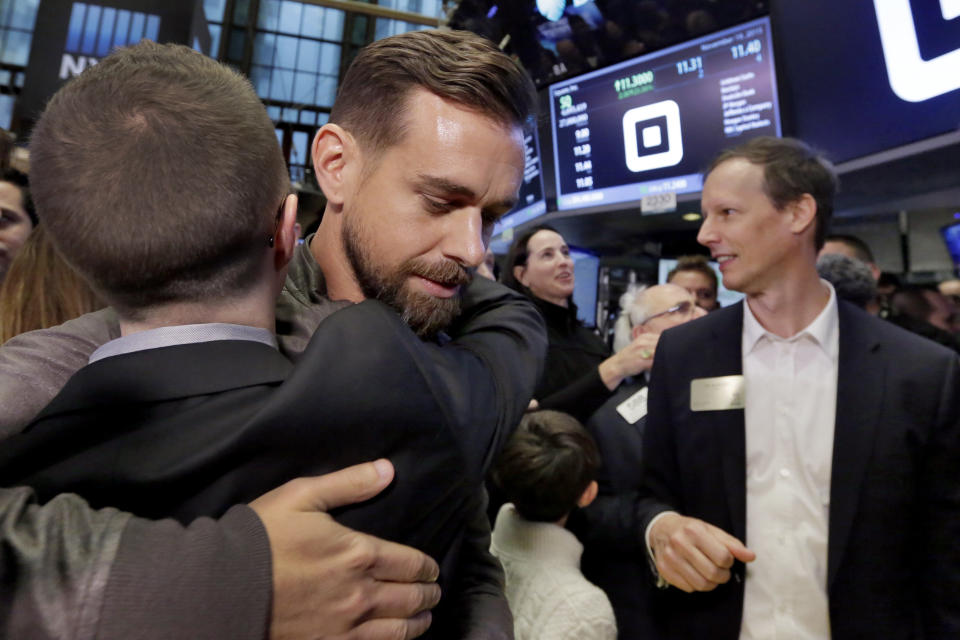Square is Yahoo Finance's 2018 Company of the Year
Square, the red-hot payments company founded by Jack Dorsey and Jim McKelvey in 2009, has grown up a lot in the past 10 years.
Square’s investors know it. The stock was up 72% through Dec. 14. Before the larger market pullback that began in October, shares were up 170% through the end of September. In just the past 13 months, Square has launched three new hardware devices: Register, an all-in-one point-of-sale system targeting larger sellers than Square serviced in the past; Terminal, a sleek brick for swiping, inserting, or tapping a credit card without needing an iPhone or iPad; and a new (Lightning-port compatible) version of its Reader, the flagship fob that plugs into a phone or tablet to take a card swipe. Speaking of cards, Square whittled down its chip-card processing time to 2 seconds flat this year.
Square also acquired catering service Zesty to bolster Caviar, the restaurant delivery app it bought in 2014; it acquired website-building platform Weebly; it saw enormous adoption growth of its peer-to-peer wallet Cash App, surpassing competitor Venmo in total downloads; and it made waves when it added the ability to buy bitcoin through Cash App.
For all this, Square is Yahoo Finance’s Company of the Year for 2018.

In making this editorial decision each year, we take into account stock performance, sales growth, product innovation, and analyst sentiment. We also poll our readers on their pick; the top reader picks this year were Amazon, Apple, and Tesla, with Square at No. 8.
Square, with $26 billion in market cap and 2,300 employees, might look like a surprising choice compared to our picks in the past few years, all much larger companies: Facebook in 2015, Nvidia in 2016, and Amazon last year. But Square is rapidly making itself a force to be reckoned with in financial services. In November, the company forecast 60% growth for 2018 and more than $3.2 billion in revenue.
Yahoo Finance visited Square headquarters in San Francisco and spoke with Square’s top executives, as well as a broad swath of analysts who cover the company. Read on to hear about Square’s remarkable year, and why 2019 could be even bigger.
Designing for a ‘delightful experience’
Square in its early days was associated with a single product: Square Reader, the white, square fob sticking out of an iPad or iPhone at your local indie coffee shop. (Along one wall inside Square headquarters on Market Street in San Francisco, there’s a nostalgic display of 18 past iterations of the fob.) Square offers its magstripe-card Reader to merchants for free, and as Square’s hardware lead Jesse Dorogusker says, “Nothing beats ‘free to get started.’ It’s a really clean message, it’s consistent and persistent.”
The device’s design is also pleasantly self-explanatory: one look, and you know what it does.
But Square has diversified its hardware line over the years, and now offers an extensive range of software and services on top of its devices, from payroll to appointment booking to delivery to catering to lending. “We’ve finally achieved the ability to build all-in-one devices,” says CEO Jack Dorsey, who only agreed to answer a select few questions via email. “Square Register and Square Terminal each strengthen the reasons we think sellers chose Square: we’re fast, self-serve, cohesive, and elegant.”

Square could have been a much more boring story. It could have been just a back-end, business-to-business company, explained simply: It provides hardware and software to more than 2 million sellers, and charges a flat 2.75% fee on every credit card swipe. But Square prioritized design, making it a brand that shoppers recognize.
Most people barely notice their point-of-sale experiences; they simply swipe or insert their card in whatever hunk of metal sits in front of them at the cash register. But people notice Square devices, and tend to enjoy using them. “We want the products people use when they make payments to look as nice as the products they use in their personal lives,” says Dorogusker. “We try to not ignore the consumer and the store employee; it’s not just about the business owner. We want to give a delightful experience for all the constituents.”
Sound like any other big tech company you know? No surprise: hardware lead Dorogusker spent eight years at Apple before joining Square. (The inside of Square’s offices even looks like an Apple Store.) And like Apple, Square’s services are growing; it’s no longer about just the hardware.

A ‘very sticky network’
The word you hear over and over when you speak to people at Square is “ecosystem.”
In the third quarter of 2018, Square reported $882 million in revenue; 74% of that was “transaction-based revenue.” (Square has beat expectations on revenue every quarter since it went public.) Square can be agnostic about which of its devices facilitates each transaction.
Whatever the entry point is for a seller, Square has become very good at luring that seller into the broader suite of Square products and services. Its revenue from subscriptions and services was up 155% year-over-year in the third quarter, driven by Instant Deposit, Cash Card (a debit-card feature through Cash App), and Square Capital, its lending business.
Square also reported its first quarterly profit in Q3 of $19.6 million, but the profit was entirely thanks to Square’s investment in ticketing startup Eventbrite. Square made a partnership with Eventbrite last year to become its main payment processor and invested $25 million; this year, when Eventbrite went public, Square’s investment converted to common stock and doubled in value, giving a gain of $37 million. Although Square’s first profitable quarter was prompted by an atypical windfall, the Eventbrite investment is no outlier in terms of its business; partnering with a hot ticketing marketplace is another step that makes sense for Square.
“The intention is to build a very sticky network,” says Wedbush analyst Moshe Katri. “Devices is not how they’re going to make their money. These are just a way to make their whole offering sticky. The big picture is about their services, and frequency of usage. PayPal is trying to do the same thing.”
A small business, like a craft jewelry seller, may start out using only Square Reader, or using only Square’s point-of-sale software paired with a non-Square cash register, then discover the ease of integrating with Square’s other products, which all speak to each other.
Many small businesses stitch together products and software from multiple providers, like a credit-card reader from Verifone, software by Worldpay, and so on. But in many cases, says Square’s seller lead Alyssa Henry, “What we’re actually competing against isn’t other software or hardware providers, it’s pen and paper. It’s a basic cash drawer. And it’s just too hard for them to change to a new system, and they’re really, really busy, and many people just give up. We make it easy.”
Square’s ecosystem is still “underappreciated,” in the eyes of Wolfe Research analyst Darrin Peller: “They attach other products and offerings around payments better than any company I’ve ever seen.”
Caviar, the food delivery app Square bought in 2014, also fits with the ecosystem. The startup launched in 2012 with the hook that it delivered from restaurants that did not previously offer delivery. “We liked Caviar because of its deep relationships with restaurants,” says Caviar lead Gokul Rajaram, widely known in Silicon Valley for his prior work on Google AdSense. “That aligned with Square’s philosophy.”
Caviar has much smaller U.S. market share than GrubHub, Uber Eats, and DoorDash, but it’s big in San Francisco (27% share), and growing quickly. Its pitch to restaurants is the Square ecosystem: Caviar delivery couriers can get paid through Cash App, and now get free accident insurance from Square; restaurants on Caviar can get a small-business loan from Square Capital with three clicks, and Square uses Caviar volume as a predictor to assess the size of loan. (The average loan is around $6,000 and Square Capital has loaned more than $3.5 billion.)
“We go in and say not just, ‘We are an online ordering platform,’” says Rajaram, “but ‘Hey, we are part of this bigger company Square, and this ecosystem with online ordering, payroll, lending, that can all work for you.’” Everything has a way of plugging into the rest.
And the ecosystem was always the plan. Glenn Solomon, a partner at GGV Capital, which invested in Square’s Series E round in 2014 before it went public, says that when he first met Dorsey in 2010, “The way he laid out the story for what he wanted to build with Square is exactly consistent with where they are right now. It is one of the few companies I’ve seen in my 20 years in venture capital that has been completely consistent with what they wanted to build.”
Bigger merchants, bigger competition
Square defines any merchant with annualized payment volume of $125,000 or less as “micro sellers,” and anything above that level a larger seller. (That bar is lower than most other payment processors define it.) The “micro merchant” segment is Square’s bread and butter, and among them, its brand is untouchable. KeyBanc Capital Markets analyst Josh Beck says when he surveys micro-merchants that use Square, “You’d be surprised the number that did not even consider anyone else. It’s because they have such a strong brand and get so many referrals.”
Now Square is increasingly going after larger merchants. Its Register and Terminal devices are part of that effort, and Square is making fast progress there: 52% of its gross payment volume now comes from larger sellers.
“I’m happy to say that Square has helped blur the line between sizes of businesses,” says Dorsey.
But Square is now competing more head-to-head with big, back-end payments players like First Data, Global Payments, and Worldpay. “It used to be that Square barely ever saw competition,” says analyst Peller, “because they were dealing with just small merchants.” Square also has to worry about PayPal—and not just PayPal-owned Venmo. PayPal’s $2.2 billion acquisition of European payments company iZettle this year was also a shot at Square, which has not yet expanded meaningfully into Europe.

As Square continues to pitch larger merchants that have used older payment providers for decades and might resist switching, it could find more resistance in adoption.
Dorsey, unsurprisingly, says Square’s biggest competitor is “always ourselves.”
Cash App is surging
Adoption of Cash App, which first launched in 2013, was a particular high point in 2018. Square has not shared the app’s monthly active user count since December 2017, when the number was 7 million. Venmo has never shared its number. Research firm eMarketer estimates Venmo at 23 million monthly active users and Cash App at 10 million.
But Square made enormous gains this year on Venmo. Nomura Instinet analyst Dan Dolev, using Sensor Tower mobile data, estimates 39.9 million total cumulative downloads of Cash App, compared to 37.1 million of Venmo.
Of course, downloads are not the same as monthly active users; Venmo is still ahead. (Dolev pegs Cash App at 13.6 million users.) In New York City, Venmo has better name-brand recognition; it is the default mobile wallet app that millennials know. But analysts say Cash App is bigger than Venmo in the Southeast—and Google Trends backs that up. In states like Florida, Georgia, Tennessee and Texas, Cash is king.

Dolev says Cash App downloads surpassed Venmo downloads for the first time in July. That was shortly after Square added a number of new features to the app, including bitcoin and “boosts,” which suggests that these features drove a wave of new buzz for the app.
Cash Card is a physical Visa debit card that carries the balance from your Cash App and isn’t connected to a bank; “boosts” are a new feature this year that give cardholders an instant discount at participating stores of their choice, including Chipotle and Starbucks. Cardholders can only have one boost activated at a time and can easily swap out boosts inside Cash App.
Square announced in November 2017 it was testing a bitcoin-buying feature on Cash App; the stock popped 16% and crypto enthusiasts cheered Dorsey on. “That’s certainly not why we did it,” says Cash App lead Brian Grassadonia, whose own Cash Card is engraved with the bitcoin symbol. “It comes back to democratizing access to financial tools that have historically been really complicated, intimidating, and stressful.”
Analysts frame it in less wide-eyed terms: it was a marketing move. (It certainly hasn’t been financially meaningful for the company yet: Square made $420,000 in bitcoin profit in the second quarter and $555,000 in the third quarter.)
“They hopped on the crypto bandwagon, got tons of press, and it significantly increased awareness of Cash App and drove a lot of downloads,” says analyst Beck. “To me, it was a brilliant customer acquisition strategy.”
[Read more about Square’s embrace of bitcoin.]
Square doesn’t buy into the “Cash App vs. Venmo” framing anyway, because it doesn’t view Cash App as just a peer-to-peer wallet. Cash App is a play for the underbanked, which means it fits perfectly with Square’s corporate mission of economic empowerment. (That mission comes directly from Dorsey, Square employees say.) Square is extremely proud that 85% of Square sellers are located outside the 25 most populous U.S. cities.
Cash App, with its rewards, direct deposit, and ease of use, is geared toward consumers who don’t already have five credit cards in their wallet, and don’t have many sources of reward points. “Their alternatives may be a prepaid card,” says Beck. “Over time, Cash App can effectively become a bank account for underserved individuals.”
2019 could be ‘even better’
Cash App is one of the businesses at Square that analysts are most bullish on for next year. “I think the Cash app will be the big breakout for them in 2019,” says Beck. “They’ve planted the seeds.”
Nomura’s Dolev also believes 2019 will be “an even better year” for Square. He expects payment volume coming from large merchants to accelerate further, adoption of Cash App to grow across the U.S., and he is waiting for Square to expand more into Europe.
“This is pretty much one of the only companies,” Dolev says, “that I can say with a great degree of certainty that they’re going to win over the next few years.”

Jack Dorsey’s double-duty
There’s no obvious bear case against Square right now, but there are potential trouble spots.
For starters, some analysts fear the stock went too high this year and is overvalued, even after shares took a 20% hit when Square announced CFO Sarah Friar was leaving for the CEO job at neighborhood social network Nextdoor. Friar was extremely popular with Wall Street, and was the face of the company apart from Dorsey; Square says replacing her is a top priority. (It has named Timothy Murphy and Mohit Daswani interim CFOs.) “There are still some investors I talk to who are skeptical and worry that Sarah left because she had doubts, but I think that’s all nonsense,” analyst Peller says.
Peller enumerates another potential issue: a recession. Square has a high percentage of revenue coming from small merchants, which are thought to be especially vulnerable in a recession. Still, Peller projects Square revenue to grow by 45% in 2019.
Finally, there’s Jack Dorsey. Lest anyone forget, he is pulling double-duty as the CEO of Twitter. Scott Kessler of CFRA Research calls that situation “unsustainable” and predicts that in 2019 Dorsey will step down as CEO from one of the companies, maybe to serve as chairman instead.
Square’s top executives all balk at the question of whether Dorsey’s double-duty is an issue. “I think if I didn’t use Twitter and read about Twitter, I wouldn’t even know,” says Dorogusker.
That claim is a bit of a stretch, but certainly in 2018, as Twitter has become a lightning rod for political controversy, Square is less divisive and easier to evaluate: it is a massive success.
—
Daniel Roberts is a senior writer at Yahoo Finance and closely covers fintech. Follow him on Twitter at @readDanwrite.
Read more:
Exclusive: The SEC tightens the noose on ICOs
Exclusive: Coinbase cuts staff
Payments company Circle: ‘We never left bitcoin’

 Yahoo Finance
Yahoo Finance 